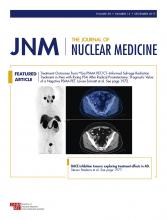GRPR vs. PSMA in prostate cancer: Iagaru looks at the comparative advantages and challenges of prostate-specific membrane antigen− and gastrin-releasing peptide receptor−targeting PET radiopharmaceuticals in prostate cancer.
Page 1883
In vitro evaluation of molecular tumors: Reubi presents the case for employing receptor immunohistochemistry to evaluate potential molecular targets in human tumor tissue sections, with a focus on immunohistochemistry of G-protein–coupled receptors.
Page 1885
18F-FDG PET in parkinsonism: Meyer and colleagues provide an educational overview of current data on the utility of 18F-FDG PET in diagnostic evaluation of parkinsonism and the associated potential for assessment and risk stratification of cognitive impairment.
Page 1888
Theranostic targets in pancreatic cancer: Koller and colleagues report on data-driven prioritization of significantly upregulated proteins in pancreatic ductal adenocarcinoma as potential targets for molecular-based theranostic approaches.
Page 1899
NM training in Europe: Muylle and Maffioli offer perspective on the diversity of training requirements for nuclear medicine physicians in European countries and recent efforts to provide innovative education in emerging modalities and theranostic applications.
Page 1904
18F-FDHT and 18F-FES PET in breast cancer: Venema and colleagues describe concordances between 18F-FDHT and 18F-FES PET imaging and tumor androgen and estrogen receptor expression in patients with metastatic breast cancer.
Page 1906
Dual-timepoint PET/CT in vulvar cancer: Collarino and colleagues assess the value of 18F-FDG PET/CT at 1 and 3 h after tracer injection in prediction of lymph node status in patients with invasive vulvar cancer scheduled for inguinofemoral node dissection.
Page 1913
HNSCC malignancy detection: Rohde and colleagues determine detection rates for distant metastases and synchronous cancers by comparing chest x-ray or CT/head and neck MR imaging with 18F-FDG PET/CT in diagnostic workups of patients with oral, pharyngeal, or laryngeal cancer.
Page 1919
PET and NSCLC outcomes: Steiger and colleagues explore volume-based PET metrics, including metabolic tumor volume, total lesion glycolysis, and background activity–based PET measurements, as prognostic markers for progression-free and overall survival in early-stage non–small cell lung cancer.
Page 1925
Early 18F-FDG PET and CT response: Fledelius and colleagues identify an optimal method for early evaluation with 18F-FDG PET/CT for prediction of later response on CT in patients with erlotinib-treated non–small cell lung cancer.
Page 1931
PSMA PET/CT of synchronous malignancy: Osman and colleagues evaluate the incidence of synchronous primary malignancies in patients undergoing 68Ga-labeled prostate-specific membrane antigen PET/CT for prostate cancer.
Page 1938
PSMA PET/CT and primary PCa: Koerber and colleagues use 68Ga-labeled prostate-specific membrane antigen PET/CT to evaluate SUVs in benign tissue and malignant intraprostatic tumors in patients with newly diagnosed prostate carcinoma and compare these with clinical parameters.
Page 1943
PSMA PET/CT lymph node–positive PCa: Vinsensia and colleagues correlate the dimensions, volume, localization, and SUVmax of nodal metastases identified by 68Ga-PSMA with Gleason score at diagnosis in men with prostate-specific antigen relapse.
Page 1949
68Ga-PSMA-11 PET and patient management: Hope and colleagues estimate the effect of 68Ga-labeled prostate-specific membrane antigen-11 PET on the intended management of patients with biochemically recurrent prostate cancer.
Page 1956
Volumetric 68Ga-PSMA ligand PET: Schmuck and colleagues evaluate whether prostate-specific membrane antigen ligand PET/CT can provide PSMA-derived volumetric parameters for quantification of whole-body tumor burden in patients with metastatic prostate cancer.
Page 1962
PSMA agents and prostate cancer: Hicks and colleagues provide perspective on the successes of 68Ga-labeled prostate-specific membrane antigen agents and preview a paper in this month’s JNM on the prognostic significance of a negative 68Ga-PSMA-11 scan in salvage radiotherapy.
Page 1969
68Ga-PSMA PET–informed treatment: Emmett and colleagues examine the value of prostate-specific membrane antigen–informed salvage radiation treatment in improving outcomes in the context of biochemical failure after radical prostatectomy.
Page 1972
BACE inhibition in transgenic mice: Deleye and colleagues use multitracer PET imaging to investigate the effects of chronic administration of an inhibitor of the β-site amyloid precursor protein–cleaving enzyme 1 on Alzheimer-related pathology in APPPS1-21 mice.
Page 1977
Dual-tracer PET in aging mice: Brendel and colleagues use 18F-FDG and translocator protein small-animal PET to directly examine the link between neuroinflammation and hypermetabolism in aged wild-type mice.
Page 1984
Collagen probe for fibrosis imaging: Désogère and colleagues describe the assessment of several collagen-targeted peptides as PET tracers, including 64Cu-CBP7, a promising probe for identifying and staging pulmonary fibrosis.
Page 1991
18F-FCP PET: Lamichhane and colleagues report on an 18F-labeled carboplatin derivative with the potential for personalized PET imaging of drug uptake and retention, including intratumoral distribution.
Page 1997
18F-FTC-146 dosimetry: Hjørnevik and colleagues assess the safety, biodistribution, and radiation dosimetry in humans of this highly selective σ-1 receptor PET agent with potential for application in a variety of neuroinflammatory diseases.
Page 2004
Adverse reactions to radiopharmaceuticals: Kennedy-Dixon and colleagues look at reports submitted to the British Nuclear Medicine Society’s online database in a 10-year period to determine the prevalence of adverse reactions associated with radiopharmaceuticals.
Page 2010
MBF with SPECT or PET: Wells and colleagues compare myocardial blood flow and myocardial flow reserve measurements acquired with 99mTc-tetrofosmin SPECT and with 82Rb or 13N-ammonia PET.
Page 2013
Scatter correction in 15O-gas PET: Magota and colleagues examine the validity of a newly developed scatter-correction method for accurate quantitative assessment in 15O-gas brain PET that combines single-scatter simulation with a scaling factor calculated by Monte Carlo simulation.
Page 2020
AUC for 18F-FDG PET/CT: Jadvar and colleagues from U.S. and European molecular imaging and oncology associations present evidence-based appropriate use criteria for 18F-FDG PET/CT in restaging and treatment response of malignant disease.
Page 2026
- © 2017 by the Society of Nuclear Medicine and Molecular Imaging.







